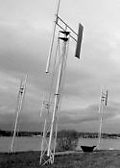THEY SAID THEY’D BE BACK, and here they are.
A group of Seattle City Council members who narrowly lost a vote in late November are already seeking reconsideration of a proposal to enrich the city’s arts coffers. The city’s One Percent for Arts program now sets aside a percentage point of public construction budgets, mostly for on-site visual arts. Council members who support raising the arts set-aside to either 1.5 percent or 2 percent are pushing for a quick vote on the matter.
Supporters argue the proposal has been on the table for months and was discussed extensively before last November’s 5-4 council vote instructing Mayor Paul Schell to drop any increase in the arts funding program from his 2001-02 budget.
Council President Margaret Pageler, who pushed for last year’s vote before two new arts-friendly council members, Heidi Wills and Judy Nicastro, took office, now seems a couple votes short of repeating her victory. She says the principle be- hind her action hasn’t changed—with city monies depleted because of Initiative 695, the council needs to identify which programs will be cut to benefit the arts. “I’m not philosophically opposed to funding for the arts,” she says, “but we need a reality check here.”
Council member Richard McIver is another opponent of the increase, which he sees as financially irresponsible. At a time when the city is trying to address the effects of I-695 and anti-affirmative action Initiative 200, the proposed arts funding increase would take “cash flow that ought to be dedicated to human need,” says McIver. He criticizes his colleagues pushing proposals like Two Percent for the Arts and a ban on performing animals at a time when the city has just lost $4.9 million in transportation funding. “So we come up with the arts and the circus? Give me a break,” he says.
But council penny-pinchers face tough opposition from a newly active arts lobby, whose members carefully extracted campaign trail promises from the six council members elected in the last two election cycles. Her new colleagues are on the record backing the funding boost, says Nicastro, who declares herself “an absolute supporter” of the 2 percent proposal. Other backers are more cautious: Council member Richard Conlin gripes about the fast track the proposal is on in his latest e-mail newsletter. Conlin would prefer a more comprehensive approach to all the types of arts funding that the city should or does provide, including his long-awaited proposal addressing the crisis in the underage music scene. Still, he intends to support the increase.
The Allied Arts organization has organized an e-mail campaign, which has already pumped more than 100 letters favoring the funding increase into each council member’s computer system. Alex Steffen, Allied Arts president, notes of the proposed jump to 2 percent: “It’s a couple drops in the bucket in terms of everything the city spends.”
Without an increase, the One Percent for Arts program would raise $1.85 million for the arts in 2001. That number would rise to $2.4 million with a 1.5 percent set-aside, and $3.2 million at 2 percent.
Other arts funding discussions are expected to follow later this year. Council member Nick Licata says that future issues will include whether the city contribution to public/private partnerships should be tapped and whether utility projects outside city limits should also contribute to the fund.






